Arado Ar 196
Les utilisateurs étrangers - Foreign users
Bulgarie - Bulgaria
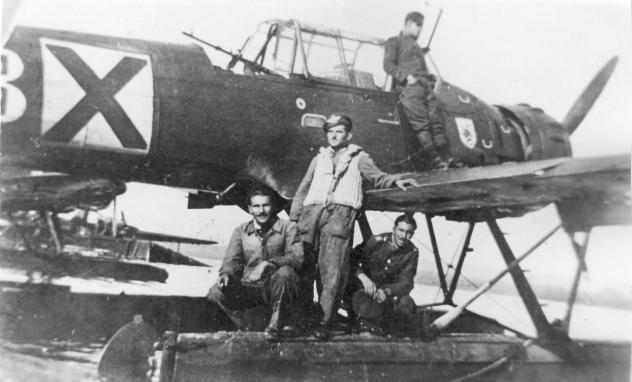 Arado Ar 196 A-3
Arado Ar 196 A-3
161ème escadrille, Varna, Bulgarie - 161st Squadron, Varna, Bulgaria.
photo : source inconnue - source unknown
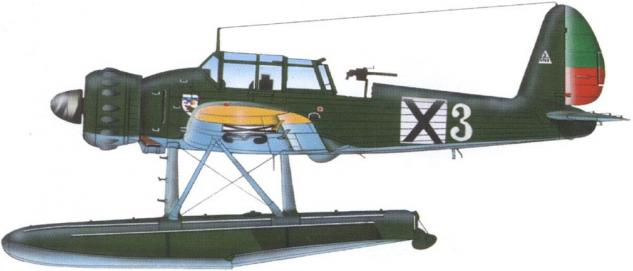 Arado Ar 196 A-3 - Varna, 1943-1944
Arado Ar 196 A-3 - Varna, 1943-1944
artiste inconnu - artist unknown - source : http://wp.scn.ru
Allié de l'Allemagne, la Bulgarie demande aux allemands des hydravions pour défendre ses côtes sur la Mer Noire. Promis pour juillet, août et septembre 1942, 12 Arado Ar 196 seront finalement achetés et livrés à la Bulgarie en avril 1943. Entre-temps, les équipages s'entraîneront sur Heinkel 42 et 60. Ce seront des A-3 d'occasion, numérotés 219, 244, 245, 247, 252, 253, 255, 256, 257, 258, 261 et 262.
Allied with Germany, Bulgaria claimed for seaplanes to Germany to protect its coasts on Black Sea. Promised for July, August and September, 1942, 12 Arado Ar 196 were finally bought and delivered in Bulgaria in April, 1943. Meanwhile, crews trained on Heinkel 42 and 60. The Ar 196 were second-hand A-3, numbered 219, 244, 245, 247, 252, 253, 255, 256, 257, 258, 261 and 262.
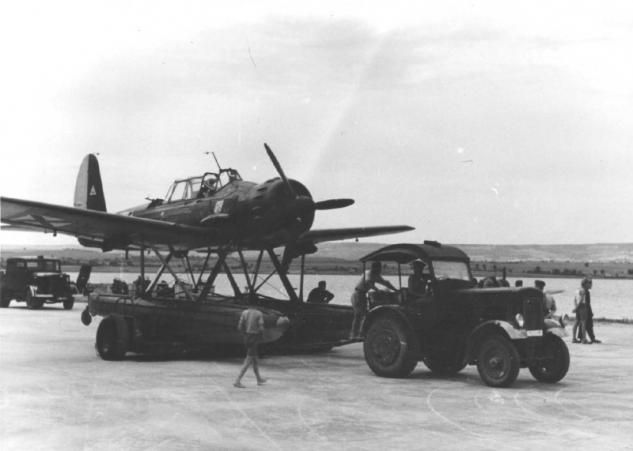 Arado Ar 196 - Bulgarie, Bulgaria
Arado Ar 196 - Bulgarie, Bulgaria
photo : source inconnue - source unknown
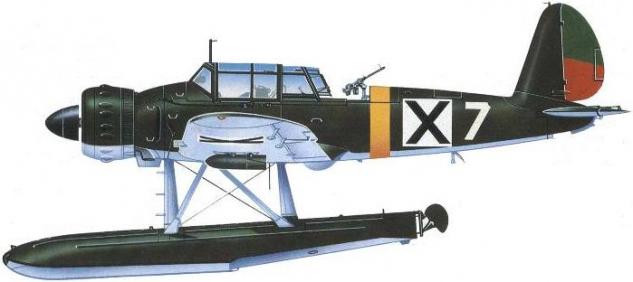 Arado Ar 196 A-3 - Varna
Arado Ar 196 A-3 - Varna
artiste inconnu - artist unknown - source : http://wp.scn.ru
L'Ar 196 sera baptisé "Akula" (requin) par les Bulgares qui commenceront leur entraînement et leurs missions en juin 1943. Les Ar 196 seront affectés à la 161e escadrille d'hydravions, du 1er régiment de reconnaissance. En septembre 1944, la Bulgarie rejoint l'URSS contre l'Allemagne.
The Ar 196 was nicknamed "Akula" (shark) by the Bulgarians who began their training and missions in June, 1943. the Ar 196 were allocated to the 161th seaplanes squadron, 1st reconnaissance regiment. In September, 1944, Bulgaria joined the USSR against Germany.
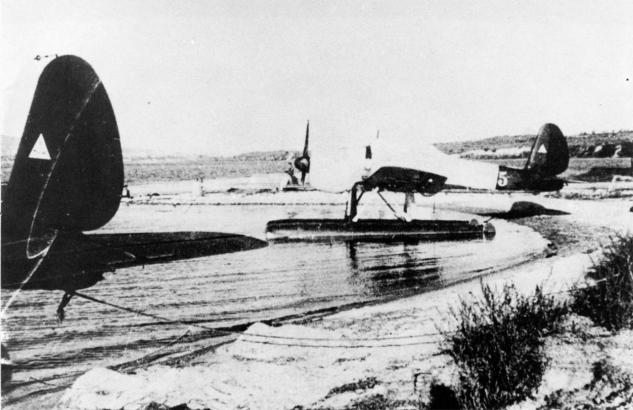
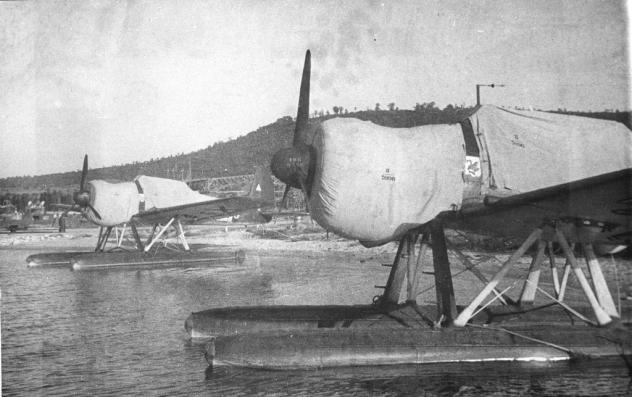 Arado Ar 196 "3" & "5"
Arado Ar 196 "3" & "5"
161ème escadrille, Mer Noire, Bulgarie, 1945
161st Squadron, Black Sea, Bulgaria, 1945
photo : source inconnue - source unknown
Un équipage (pilote Ivan Dentchev et observateur Radoslav Boyadjiev) s'enfuit avec un Ar 196 et amerrit en Turquie où il sera interné. L'Arado sera échangé en 1946 contre un Spitfire turc égaré.
A crew (pilot Ivan Dentchev and observer Radoslav Boyadjiev) escaped with an Ar 196 and landed at sea in Turkey where they were interned. The Arado was exchanged in 1946 against a Turkish Spitfire lost some time before in Bulgaria.
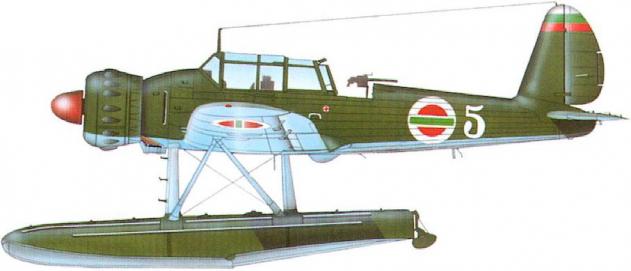 Arado Ar 196 A-3 - Varna, 1945
Arado Ar 196 A-3 - Varna, 1945
artiste inconnu - artist unknown - source : http://wp.scn.ru
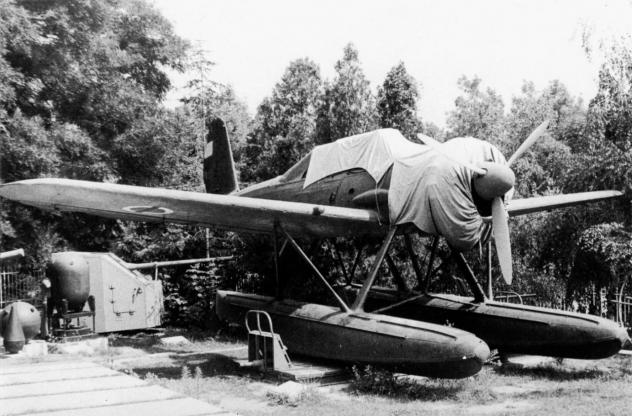 Arado Ar 196 "5"
Arado Ar 196 "5"
161ème escadrille, Bulgarie, 1946 - 161st Squadron, Bulgaria, 1946
photo : source inconnue - source unknown
U.R.S.S. - U.S.S.R.
De nombreux Ar 196 et leurs pièces de rechange seront capturés sur les côtes polonaises et, en 1945, en Allemagne. Seuls les gardes frontière soviétiques seront intéressés par ces appareils, suprieurs à leurs vieux MBR-2 et Ch-2. Rassemblés à Darmgarsten, 18 Ar 196 seront réparés et essayés. D'autres seront réparés dans divers ateliers et les gardes frontière récupéreront au total 37 appareils. Un premier groupe de 10 avions sera acheminé par les airs en Mer Baltique (Pyarna) et en Mer Noire (Odessa). Un Ar 196 ira même jusqu'à Moscou. D'autres appareils seront expédiés dans le Pacifique par train.
A lot of Ar 196 and their spare parts were captured on the Polish coast and, in 1945, in Germany. Only the Soviet border guards were interested by these aircrafts, superior to their old MBR-2 and Ch 2. Gathered in Darmgarsten, 18 Ar 196 were repaired and tested. Others were repaired in diverse places and the border guards received 37 units. A first group of 10 aircrafts were forwarded by the air in the Baltic Sea (Pyarna) and in the Black Sea (Odessa). One Ar 196 even flew to Moscow. Other aircrafts were sent in the Pacific by train.
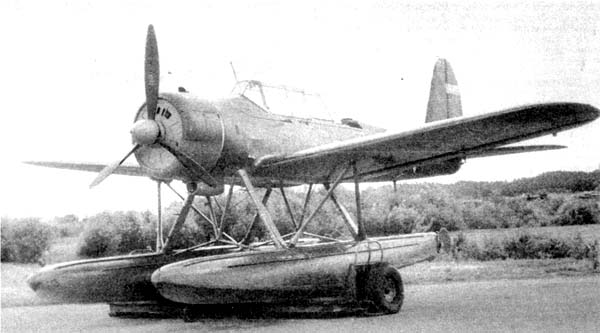 Arado Ar 196 - Moteur ASh-621R, ASh-621R engine
Arado Ar 196 - Moteur ASh-621R, ASh-621R engine
photo : source inconnue - source unknown
Une étude pour remplacer le moteur BMW de l'AR 196 par un ASh-621R (copie du Wright Cyclone R-1820) sera faite et un appareil modifié en 1949. Finalement, des BMW 132 K récupérés sur des Junkers Ju 52 réformés seront utilisés pour les Ar 196. Les Ar 196 seront retirés du service en 1955.
A study to replace the engine BMW of the AR 196 by an ASh-621R (copy of Wright Cyclone R-1820) was conducted and an aircraft modified in 1949. Finally, BMW 132 Ks taken on obsolete Junkers Ju 52s were kept for Ar 196. The Ar 196 were removed from service in 1955.
Roumanie - Romania
La Roumanie a commandé à l’Allemagne 50 Arado Ar 196. Les premières livraisons seront tardives : 24 appareils livrés à l’été 1944 mais l’approche des soviétiques en août semble avoir empêché leur utilisation. 22 seront confisqués par les soviétiques et les 2 autres probablement montés mais non utilisés par les Roumains.
Romania ordered in Germany 50 Arado Ar 196s. The first deliveries were late : 24 units delivered in summer, 1944 but the approach of the Soviets in August seems to have avoided their use. 22 were seized by the Soviets and the 2 others probably assembled but not used by the Romanians.
Japon - Japan
Au moins un Arado Ar 196 (peut-être deux) fut envoyé à la base sous-marine de Penang (Singapour). Les versions divergent sur les couleurs (japonaises ?) de cet avion. Après la capitulation allemande de mai 1945, l’appareil est cédé aux Japonais mais on ignore si un pilote japonais l’a essayé.
At least one Arado Ar 196 (maybe two) was sent to the submarine base of Penang (Singapore). The colors of this aircraft (Japanese?) are unknwon. After the German surrender of May, 1945, the aircraft was given to the Japanese but we ignore if a Japanese pilot tested it.
Finlande – Finland
Trois Arado Ar 196, prêtés par l’Allemagne, seront utilisés par la Finlande :
- Le « GA+DO » W.Nr. 0115 est utilisé du 13 septembre au 29 octobre 1943 pour des missions de soutien de commandos derrière les lignes ennemies.
- Les Ar 196 A-3 « A3+AC » (prêté le 30 juin 1944 par le KG 200) et « A3+BC » (prêté le 6 août) accompliront 45 missions contre les soviétiques jusqu’au 4 septembre 1944. Le « A3+BC » s’écrasera le 5 septembre et le « A3+AC » sera remis aux soviétiques.
Three Arado Ar 196, lent by Germany, were used by Finland :
- The " GA+DO " W.Nr. 0115 was used from September 13th till October 29th, 1943 for support missions of commandos behind the enemy lines.
- The Ar 196 A-3 "A3+AC" (lent on June 30th, 1944 by KG 200) and "A3+BC" (lent on August 6th) achieved 45 missions against the Soviets until September 4th, 1944. The "A3+BC" crashed on September 5th and the "A3+AC" was given to the Soviets.
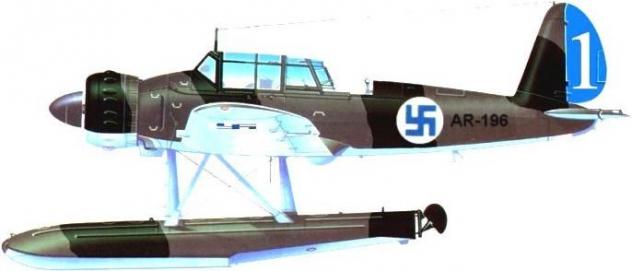 Arado Ar 196 - Finlande - Finland
Arado Ar 196 - Finlande - Finland
artiste inconnu - artist unknown - source : http://wp.scn.ru
Norvège & Angleterre – Norway & England
Le 8 avril 1940, un Ar 196 A-2 (probablement WNr 44 "T3+?H") catapulté de l'Admiral Hipper se pose à court de carburant à Lyngstad, près de Kristiansund, et est capturé par les Norvégiens. Le Lieutenant Kaare Kjos, pilote d'hydravion MF-11, le ramènera à Aunøy. Les marques allemandes sont effacées le 12 avril et les marques norvégiennes ajoutées sur la queue. Il est affecté au FA-2 (Flyavdeling) puis est envoyé le 19 avril en Angleterre. Le MAEE (Marine Aircraft Experimental Establishment) testera l'avion jusqu'à ce qu'il soit détruit le 26 avril au décollage (le pilote, le CF C.W. Byas, sera blessé).
On April 8th, 1940, an Ar 196 A-2 (probably WNr 44 "T3 +?H") catapulted from Admiral Hipper, landed short of fuel at Lyngstad, near Kristiansund, and was captured by the Norwegians. Lieutenant Kaare Kjos, pilot of MF 11 seaplane, flew it to Aunøy. The German marks were erased on April 12th and the Norwegian marks added on the tail. It was allocated to FA-2 (Flyavdeling) and then sent on April 19th to England. The MAEE (Marine Aircraft Experimental Establishment) tested the aircraft until it was destroyed on April 26th during take-off (the pilot, CF C.W. Byas, was injured).
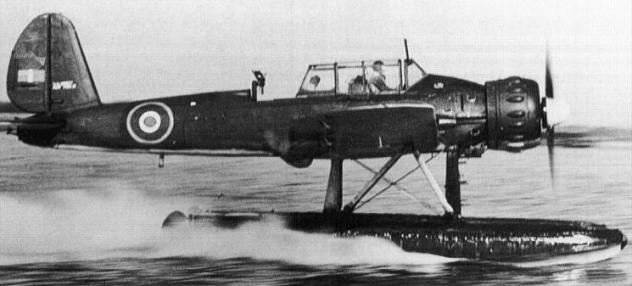 Arado Ar 196 A-5 (W.Nr. 514), 1945
Arado Ar 196 A-5 (W.Nr. 514), 1945
photo : source inconnue - source unknown
Le MAEE récupèrera également à la fin de la guerre deux Ar 196 A-5, capturés en Norvège et immatriculés AM (Air Ministry) 91 (W.Nr. 127) et AM 92 (W.Nr. 514). Ils seront féraillés le 14 novembre 1947.
The MAEE also got back at the end of the war two Ar 196 A-5, captured in Norway and registered AM (Air Ministry) 91 (W.Nr. 127) and AM 92 (W.Nr. 514). They were clattered on November 14th, 1947.
Suède – Sweden
Deux Arado Ar 196 se retrouveront en Suède : le premier fut le A-3 W.Nr. 1006 "DH+ZF" de la 4./Fl.Erg.Gr. (See) de Kamp. Parti de Copenhague le 11 février 1943, il survole la Suède suite à une erreur de navigation (équipage Uffz Ludwig Hammer, pilote, et Lt Helmut Abramowski, observateur). L'appareil est touché par un navire suédois et amerrit. L'équipage regagnera l'Allemagne mais l'appareil sera transmis à la Flotille F2 à Hägernäs. Il sera immatriculé "SE-AOU".
Two Arado Ar 196s were in Sweden : the first one was the A-3 W.Nr. 1006 "DH+ZF" of 4./Fl.Erg.Gr. (See) Kamp. It left Copenhagen on February 11th, 1943, and flew over Sweden further to an error of navigation (crew : Uffz Ludwig Hammer, pilot, and Lt Helmut Abramowski, observer). The aircraft was hit by a Swedish ship and landed at sea. The crew returned to Germany but the aircraft was given to Flotille F2 at Hägernäs. It was registered "SE-AOU".
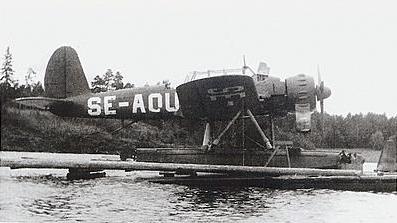 Arado Ar 196 A-3 - "SE-AOU" - photo : source inconnue - source unknown
Arado Ar 196 A-3 - "SE-AOU" - photo : source inconnue - source unknown
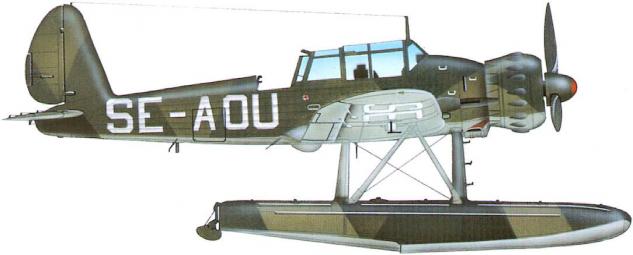 Arado Ar 196 A-3 - "SE-AOU"
Arado Ar 196 A-3 - "SE-AOU"
artiste inconnu - artist unknown - source : http://wp.scn.ru
Puis AB Kontinentagentur acquiert l'appareil en 1945, encouragé par John Turner, commandant du bureau du SIS (Special Intelligence Service) qui veut s'en servir pour transporter des agents. La guerre s'achevant en mai, Turner fait rapatrié l'Arado par son contact Norvégien en Suède, Halvor Bjørnebye, pour éviter qu'il ne parte en U.R.S.S.
Then the AB Kontinentagentur acquired the aircraft in 1945, encouraged by John Turner, commander of the S.I.S. office ( Special Intelligence Service) who wanted to use it to transport agents. The war ending in May, Turner maked repatriate the Arado by his Norwegian contact in Sweden, Halvor Bjørnebye, to avoid it to be sent in U.S.S.R.
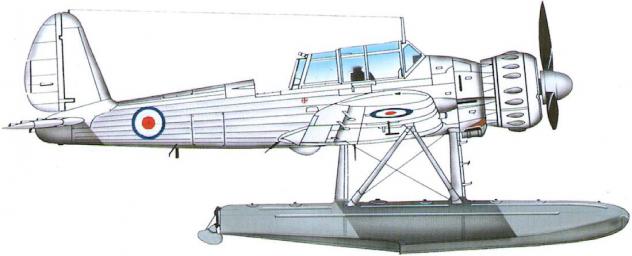 Arado Ar 196 A-3 - Stavanger-Sola, 1945 (ex- "SE-AOU")
Arado Ar 196 A-3 - Stavanger-Sola, 1945 (ex- "SE-AOU")
artiste inconnu - artist unknown - source : http://wp.scn.ru
Le deuxième Arado Ar 196 était le A-5 W.Nr. 359 "DF+QS" (E.K. Warnemünde). Du 4 au 8 mars, il essaie des flotteurs équipés de patins pour être utilisé sur la glace. Le 8 mars, son équipage (Cdt Hans Fischer, pilote et Lt Friedrich Echtenach, technicien), se perd et amerrit. Un garde-côte suédois le contraint à hydroplaner jusqu'au port d'Helsinborg. Le 11 mars, un équipage suédois l'emmène à Karlskrona où il est essayé. Puis il est rendu aux Allemands le 28 avril à Malmö.
The second Arado Ar 196 was the A-5 W.Nr. 359 "DF+QS" (E.K. Warnemünde). From 4th till 8th March, it tested ballcocks fitted with skates to be used on ice. On March 8th, its crew (Cdt Hans Fischer, pilot, and Lt Friedrich Echtenach, technician), got lost and landed at sea. A Swedish coastguard forced it to hydroplane up to Helsinborg harbor. On March 11th, a Swedish crew took it to Karlskrona where it was tested. Then it was given back to the Germans on April 28th at Malmö.
